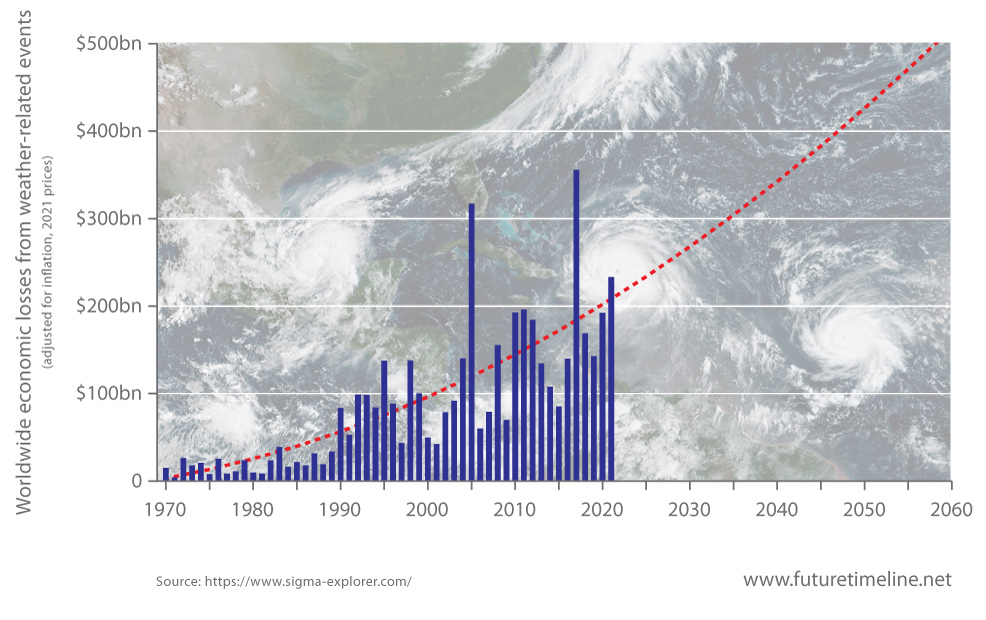- Luật
- Hỏi đáp
- Văn bản pháp luật
- Luật Giao Thông Đường Bộ
- Luật Hôn Nhân gia đình
- Luật Hành Chính,khiếu nại tố cáo
- Luật xây dựng
- Luật đất đai,bất động sản
- Luật lao động
- Luật kinh doanh đầu tư
- Luật thương mại
- Luật thuế
- Luật thi hành án
- Luật tố tụng dân sự
- Luật dân sự
- Luật thừa kế
- Luật hình sự
- Văn bản toà án Nghị quyết,án lệ
- Luật chứng khoán
- Video
- NGHIÊN CỨU PHÁP LUẬT
- ĐẦU TƯ CHỨNG KHOÁN
- BIẾN ĐỔI KHÍ HẬU
- Bình luận khoa học hình sự
- Dịch vụ pháp lý
- Tin tức và sự kiện
- Thư giãn

TIN TỨC
fanpage
Thống kê truy cập
- Online: 4
- Hôm nay: 176
- Tháng: 8015
- Tổng truy cập: 5153280
Economic losses from weather-related events, 1970-2060
This graph shows the worldwide economic losses from weather-related events, from 1970 through to the present day, with a future trend projected out to 2060.
The data here is from Swiss Re, the world's largest reinsurer, and is adjusted for inflation at 2021 prices. It excludes non-weather disasters, such as earthquakes, tsunamis, and volcanic eruptions.
A significant gap exists between the total economic damages and the losses protected by insurance. For example, the worldwide figure for weather-related disasters in 2021 amounted to $233.27 billion, of which insurance covered "only" $101.12 billion.
As the global average temperature continues to rise, so too does the frequency and severity of weather-related events; from tropical cyclones, to droughts, floods, and other disasters. Following a somewhat stable period in the 1970s and 1980s, an inflection point emerged from around 1990, producing a rapid acceleration of economic damage. Over the last 40 years, the average losses for a given year have increased ten-fold.
In terms of the worst damage, two years stand out – 2005 and 2017. The former included Hurricane Katrina and three other devastating storms touching land; the latter became the costliest tropical cyclone season on record, mostly due to hurricanes Harvey, Irma, and Maria. More recently, heat waves have trended upwards in frequency and length. Meanwhile, several European countries experienced catastrophic flooding in 2021.
As our graph shows, the magnitude of disasters witnessed in 2005 and 2017 could become an annual occurrence from around 2040 onwards. Under the current emissions scenario, in which global temperatures are likely to keep rising until at least the 2060s, these damages would only continue to mount. During "outlier" years that greatly exceed the average, economic losses could be immense, perhaps reaching $1 trillion (in 2021 prices), or equivalent to the entire GDP of nations like Saudi Arabia, the Netherlands and Switzerland. By 2060, sea levels will also be playing a far greater role than today, adding to the existing damages.
Without massive government intervention, the insurance industry may struggle to survive amidst this continual onslaught of disasters. Our economic future will depend on how we approach the problem of infinite growth on a finite planet.

By FutureTimeLine
Các bài viết khác
- Vài nét Dự báo thời đại phục hưng và khai sáng của loài người sau đại dịch Corona-2019.7-2021(khởi đầu từ tháng 9 năm giáp thìn 2024) (25.06.2021)
- Từ sự kiện Tổng biên tập báo TIME Greta Thunberg là Nhân vật của năm 2019 đến báo cáo Biến đổi khí hậu Phúc trình của IPCC báo động đỏ cho nhân loại 82021 (15.01.2020)
- Choáng trước tòa nhà siêu khủng 1.000 tỉ USD của Ả-rập Xê-út (08.08.2022)
- Bên trong nhà máy tên lửa khổng lồ của Mỹ - Nasa sẽ quay trở lại Mặt Trăng như thế nào! (08.08.2022)
- Nước ngập nửa mét bao vây chợ Thủ Đức (08.08.2022)






























 Yahoo:
Yahoo: 